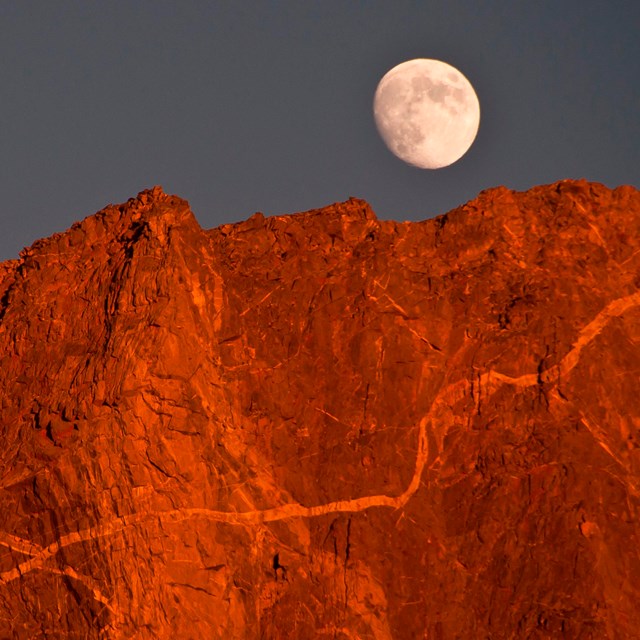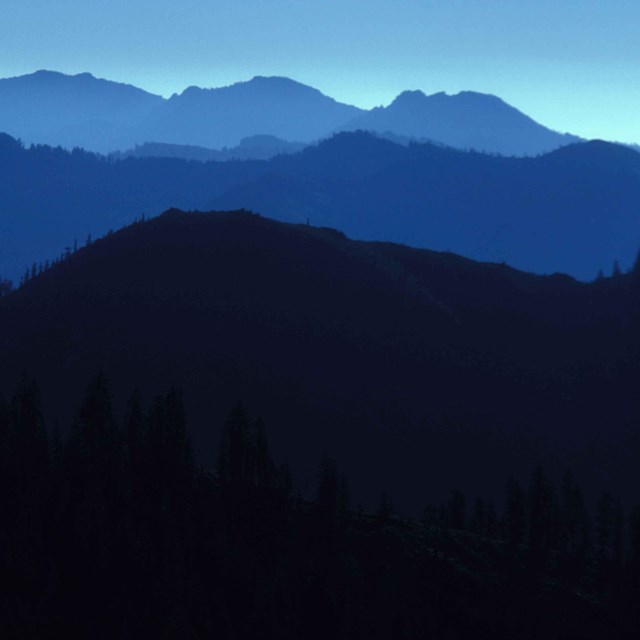
NPS / Kevin Hendricks “If future generations are to remember us with gratitude rather than contempt, we must leave them something more than the miracles of technology. We must leave them a glimpse of the world as it was in the beginning, not just after we got through with it.” – President Lyndon B. Johnson upon signing the Wilderness Act (1964)

NPS Photo What Is Wilderness?When you think of the wild, what is the first thing that comes to mind? Your backyard? A local park? A trail by the river? The rugged mountains of the Sierra? 
Sequoia and Kings Canyon WildernessSequoia and Kings Canyon is a beautiful place. Here, the towering granite peaks of the High Sierra call to those brave enough to venture into the wild. Here, lush meadows and broad lake basins lie nestled in magnificent glacial canyons. Here, there are no roads, only inspiration. 1. Designated Wilderness
2. Recommended Wilderness
3. Potential Wilderness
Together, these lands form over 850,000 acres of protected scenic landscapes. But what is it that makes these areas so special? And why protect them from modern human impact? The answer is character. Character Counts: The Qualities of Wilderness Character In order to steward a diverse ecosystem of the Sierra Nevada, the parks seek to preserve something called “wilderness character.” Wilderness character combines physical and conceptual qualities that can be used as a guideline for what the National Park Service is responsible for protecting. This includes a wealth of values: ecological, scientific, recreational, historical, and cultural.
Sequoia and Kings Canyon National Parks carry a vast and diverse range of ecosystems along the greatest vertical relief in the lower 48 states (1,370-14,505 feet in elevation). From the lowest basin of the Kings River to the oak woodlands of the foothills to the stark granite of the Sierra Crest to the summit of Mount Whitney, a huge part of the park wilderness is maintained to protect its natural ecology.
Many of the vast glacial canyons and subalpine lakes here are the same as they were hundreds of years ago. There are even three stretches of river in the parks that are a part of the national Wild and Scenic Rivers System: the Kern River and the Middle Fork and South Fork of the Kings River. In these areas, ecological systems are free from the effects of modern civilization and are allowed to thrive. Weird word, right? Historically, a “trammel” is a net used to restrain and restrict movement. Land that is trammeled then is “restricted” by the manipulation of humankind. In untrammeled lands, nature is unrestricted and able to thrive however it pleases. For expanses as large as the Sequoia-Kings Canyon Wilderness, this can include allowing lighting fires to burn, moving trails out of meadows for hydrologic flow, and allowing the natural wildlife cycles of life and death to carry on with minimal interference.
Wilderness gives us a chance to consider more traditional ways of interacting with the rest of the natural world. Here, visitors to the wild won’t find permanent improvements or the sights and sounds of modern human occupation. There are large portions of land where even rudimentary trails are nonexistent, and the only evidence of humans is the occasional boot print or arrowhead.
As you travel through the wilderness here, you may find well-established trails, signs, and bridges on the John Muir Trail or come across one of our ranger stations, which house our wilderness rangers during the busy season. Some of the developments are necessary for park operations, visitor enjoyment, and safety and are carefully monitored to ensure they don’t disturb the landscape they are housed in. There are many ways to experience the park’s wilderness. Some venturers enjoy the social aspects of a more populated trail like the High Sierra Trail or the Rae Lakes Loop. Others seek a more solitary experience, one where they don’t see or hear another person for days at a time. One of the most important aspects of wilderness is its ability to bring meaning to those who wander within it.
Visitors who walk among the ancient giant sequoias and towering granite walls feel a sense of humility and inspiration. Traveling with friends and family can bring opportunities for bonding and connection. Exploring rugged terrain allows a meaningful challenge that celebrates the power of human ability and independence. Sequoia and Kings Canyon National Parks are the homelands of the Mono (Monache), Yokuts, Tübatulabal, Paiute, and Western Shoshone.
The Sierra Nevada mountain range contains some of the oldest national parks in the nation. These parks occupy spectacular volcanic and glacial landforms, as well as distinctive subalpine and alpine habitats, setting these parklands apart from the wider landscape of central and southern California. The location’s uniqueness has made it especially important to Native Americans as well. Native peoples have used, tended, occupied, and valued the lands of the high Sierras in many ways, and they still maintain deep connections to the parks today. The displacement and often forced relocation and reorganization of Native peoples have much affected their relationships with lands in the parks, with the National Park Service itself, and with one another. Nonetheless, these tribes all have numerous descendants living today who continue to steward and tend to the lands now within Sequoia and Kings Canyon National Parks. Federal Wilderness is the Homeland of Indigenous PeoplesNational Parks like Sequoia and Kings Canyon, as well as the wilderness areas within, are the homelands of Indigenous peoples, and they have been for thousands of years. Lands now managed as federal wilderness were forcibly taken from Indigenous peoples and later, from other marginalized groups. It is imperative to recognize that what we see today is the culmination of thousands of years of intentional land stewardship by the many people connected to these places.In particular, the wilderness managed by Sequoia and Kings Canyon includes land dispossessed from more than 4 local tribes, including Yokuts, Monache or Western Mono, Tubatulabal, and Paiute (tribal identities are often more specific than these 4 broader groups). Most of our trails are built over indigenous trails, including the Nüümü Poyo (aka John Muir Trail), with its southern point at Mount Tumangaya (aka Mount Whitney). The idea of wilderness is controversial. To continue appreciating wilderness, we must acknowledge its contradictions and historical context. The 1964 Wilderness Act was a product of its time. The idea of wilderness was enshrined into law as a place, “where man himself is a visitor who does not remain.” We now understand this idea to be a myth. Federally designated wilderness was never unpopulated, untouched, empty land. Rather, indigenous people have called this land home for millennia, they have modified the land, and they continue to call this land home to the present. This is not just historically indigenous land; rather, the people of these tribes are still here. Local indigenous people do not need a wilderness permit to hike here and they do not need to pay entrance fees. Park employees and visitors must leave indigenous artifacts where found. Today, the National Park Service is working to bring indigenous people back into conversations of land management. The National Park Service is also striving to make wilderness a more inclusive, welcoming place for all people, including historically excluded people of color, women, and average working people. 
NPS Photo How We Manage the WildWilderness is a balancing act. The National Park Service constantly grapples with the tensions inherent in “managing” wilderness areas so as to make "the imprint of man's work substantially unnoticeable," in the words of the 1964 Wilderness Act. The parks manage wilderness with two priorities in mind:
Preserving wilderness character is a tough task. Park stewards must consider all aspects of wilderness character when making decisions about park operations in these areas. Sometimes, in an effort to enhance one quality, another could be impacted. To help manage this, Sequoia and Kings Canyon National Parks published their Wilderness Stewardship Plan in May of 2015. This plan describes the management policies and priorities for the parks and gives excellent examples of the complexities of wilderness stewardship. 
NPS Photo Maintaining a LegacyWilderness stewardship of Sequoia and Kings Canyon is part of a national legacy that dates back generations. The parks work hard to protect these special places, but we need your help too! As you plan your trip to the wilderness, please keep the tenants of Leave No Trace in mind, as well as park-specific restrictions for where you plan your trip. When visiting, please be sure to leave only footprints and take only memories. Have Questions About Your Trip? Contact the Wilderness Office
Explore the Wilderness
Learn More About Wilderness
|
Last updated: November 20, 2025






